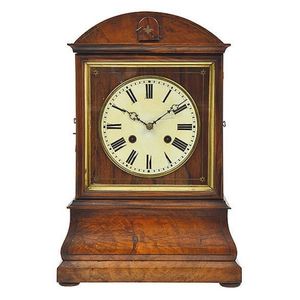Mahogany Mantel Clock with Silver Dial and Inlay
An early 20th century inlaid mahogany cased mantel clock silver dial, arabic numeral and barrel movement with pin-pallet escapement. Length 25 cm
You must be a subscriber, and be logged in to view price and dealer details.
Subscribe Now to view actual auction price for this item
When you subscribe, you have the option of setting the currency in which to display prices to $Au, $US, $NZ or Stg.
This item has been sold, and the description, image and price are for reference purposes only.
- Mahogany - Mahogany is a dense, close grained red-coloured timber from the West Indies and Central America. It was first imported into Europe in the the early 18th century and its use continued through the 19th century. It was popular for furniture making because of its strength, the wide boards available, the distinctive grain on some boards, termed flame mahogany and the rich warm colour of the timber when it was polished.. The "flame" was produced where a limb grew out from the trunk of the tree, and this timber was usually sliced into veneers for feature panels on doors, backs and cornices.
Some terms used to describe mahogany relate to the country from which it originally came, such as "Cuban" mahogany, "Honduras" mahogany etc. However unless the wood has been tested the names assigned are more a selling feature, rather than a true indication of the timber's origin. - Barrel (in a Clock) - In a clock or watch, the barrel is a cylindrical component that stores the energy from the mainspring. As the mainspring is wound, it stores energy in the barrel. As the clock or watch runs, the energy is gradually released from the barrel, turning the clock's gears and keeping the time.
The barrel is typically located near the centre of the movement (the mechanism that powers the clock) and is connected to the center wheel, which drives the rest of the gears. The barrel typically has teeth on its outer surface that mesh with the gears in the movement, allowing it to transmit energy to the rest of the clock. Some barrels are designed to be wound by hand, while others are automatically wound by the motion of the wearer's arm. - Movement - The technical name for the workings of a clock or watch, and does not include the dial or case.
This item has been included into following indexes:
Visually similar items

A 19th century walnut cased cuckoo clock eight day movement, housed in round top walnut case, standing 44 cm high base measures 30 x, 17 cm
Sold by
in
for
You can display prices in $Au, $US, $NZ or Stg.

An American early 20th century mantle clock, the dial marked S.F made in U.S.A
Sold by
in
for
You can display prices in $Au, $US, $NZ or Stg.

Royal Crown Derby 'Old Imari' clock, 10.5 cm high approx.
Sold by
in
for
You can display prices in $Au, $US, $NZ or Stg.

Victorian flame mahogany fusee bracket clock with key and pendulum. Height 50 cm
Sold by
in
for
You can display prices in $Au, $US, $NZ or Stg.
